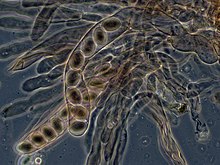
Morchella, the true morels, is a genus of edible sac fungi closely related to anatomically simpler cup fungi in the order Pezizales. These distinctive fungi have a honeycomb appearance due to the network of ridges with pits composing their caps. Morels are prized by gourmet cooks, particularly in Catalan and French cuisine, but can be toxic if consumed raw. Due to difficulties in cultivation, commercial harvesting of wild morels has become a multimillion-dollar industry in the temperate Northern Hemisphere, in particular North America, Turkey, China, the Himalayas, India, and Pakistan where these highly prized fungi are found in abundance.

Morchella conica is an old binomial name previously applied to species of fungi in the family Morchellaceae. It is one of three scientific names that had been commonly used to describe black morels, the others being M. angusticeps and M. elata. It was first introduced by mycologist Christian Hendrik Persoon in 1818, as a superfluous name for the old taxon Morchella continua. According to Richard and colleagues, Fries’ sanctioning applies only at the subgeneric level and the name is illegitimate.
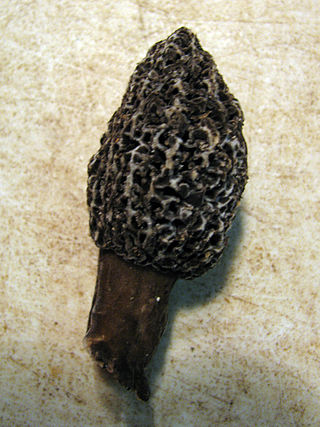
Morchella tomentosa, commonly called the gray, fuzzy foot, or black foot morel, is a species of fungus in the family Morchellaceae. M. tomentosa is a fire-associated species described from western North America, formally described as new to science in 2008.

Morchella rufobrunnea, commonly known as the blushing morel, is a species of ascomycete fungus in the family Morchellaceae. A choice edible species, the fungus was described as new to science in 1998 by mycologists Gastón Guzmán and Fidel Tapia from collections made in Veracruz, Mexico. Its distribution was later revealed to be far more widespread after several DNA studies suggested that it is also present in the West Coast of the United States, Israel, Australia, Cyprus, Malta and Switzerland.
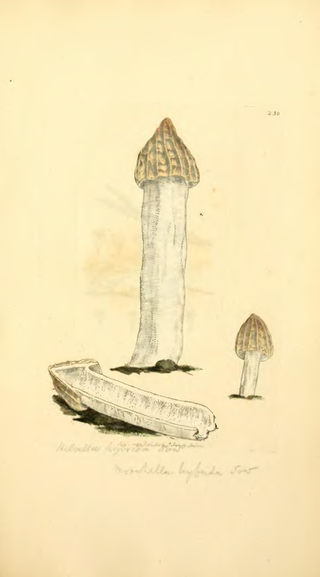
Morchella semilibera, commonly called the half-free morel, is an edible species of fungus in the family Morchellaceae native to Europe and Asia.

Morchella tridentina is a cosmopolitan species of ascomycete fungus in the family Morchellaceae. Commonly referred to as the mountain blond or western blond morel in North America, it produces conical, grey to buff fruit bodies that are rufescent and grow up to 20 cm (7.9 in) tall and 5 cm (2.0 in) wide. This early-diverging species is distinct within the /Elata clade due to its pale colours and has been described by many names in the past, including M. frustrata, M. quercus-ilicis, M. elatoides, M. elatoides var. elegans and M. conica var. pseudoeximia, all of which were shown to be synonyms. A widely distributed relict of the last Ice Age, M. tridentina is so far known from Argentina, Armenia, Chile, Cyprus, France, India, Israel, North America, Spain and Turkey.
Morchella ulmaria is a species of fungus in the family Morchellaceae. It was described as new to science in 2012 by Philippe Clowez. Later in the same year, Michael Kuo and colleagues described Morchella cryptica, which is a junior synonym of M. ulmaria. The species occurs in the forests of Midwestern North America, often associated with white ash, the American tulip tree or species of maple or elm. It is closely related to M. castanea and 2 unnamed species from Asia.

Morchella americana is a North American species of fungus in the family Morchellaceae.
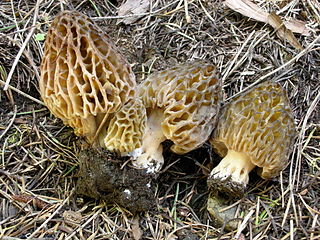
Morchella snyderi is a species of fungus in the family Morchellaceae. Described as new to science in 2012, it occurs in the montane forests of western North America, including California, Idaho, Montana, Oregon and Washington. It produces fruit bodies up to 14 cm (5.5 in) tall with ridged and pitted conical caps, and stipes that become pitted in maturity. The color of the morel is yellow to tan when young, but the cap ridges become brown to black in maturity or when dried.

Morchella importuna is a species of fungus in the family Morchellaceae described from North America in 2012. It occurs in gardens, woodchip beds, and other urban settings of northern California and the Pacific Northwest region of the United States and Canada. The fungus has also been reported from Turkey, Spain, France, Switzerland, Canada and China, although it is unknown whether this is a result of accidental introductions. It is considered a choice edible mushroom. The fruit bodies develop a distinctive ladder-like pattern of pits and ridges on the surface of their conical caps.
Morchella capitata is a later synonym of Morchella exuberans. Originally identified as phylogenetic species Mel-9, it was described as new to science in 2012 by Kuo and colleagues. In 2014 however, Richard and colleagues clarified the taxonomic status of this species, retaining the name Morchella exuberans of Clowez (2012) over M. capitata.

Morchella septimelata is a species of fungus in the family Morchellaceae described as new to science in 2012. Occurring in western North America, it has been collected from British Columbia, Montana and Oregon, where it fruits at elevations of 1,000 to 2,000 m in coniferous forests in years following slight to moderate burning.
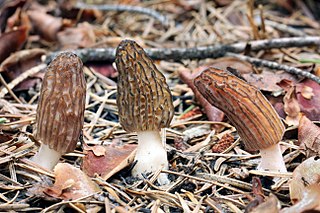
Morchella sextelata is a species of ascomycete fungus in the family Morchellaceae. Described as new to science in 2012, it is found in North America. It has also been found in China, although it is not known if this is a result of an accidental introduction or natural dispersion. The fruit bodies have a roughly conical cap up to 7.5 cm (3 in) tall and 5 cm (2 in) wide, with a surface of mostly vertically arranged pits. The cap is initially yellowish to brownish, but it darkens to become almost black in maturity. The stipe is white and hollow, measuring 2–5 cm (0.8–2.0 in) high by 1–2.2 cm (0.4–0.9 in) wide.

Morchella populiphila is a species of morel fungus native to northwestern North America. Described as new to science in 2012, its specific epithet refers to its association with black cottonwood. The morel used to be referred to as Morchella semilibera in western North American field guides until molecular analysis established that to be a strictly European species. M. populiphila occurs in California, Nevada and Oregon. Its fruit bodies grow up to 15 cm (6 in) tall with a ridged and pitted conical cap that attaches about halfway down the stipe. The cap ridges are dark brown to black in maturity, while the pits are yellowish to brownish. The fungus is edible, although not as highly valued as other morels.

Morchella anatolica is a rare species of ascomycete fungus in the family Morchellaceae. It was described as new to science in 2010 from southwest Anatolia, Turkey, where it grows on moss-covered stream beds in pine forests. An ancient climatic relict, M. anatolica is restricted to the Mediterranean basin and has also been documented in Spain, Cyprus and Greece, where it is sometimes encountered with trees of the Oleaceae family. Together with its sister-species Morchella rufobrunnea, they are the earliest diverging lineages in genus Morchella, forming a distinct clade that is basal in global morel phylogenies. Because of its phylogenetic position, M. anatolica has been crucial in inferring the historical biogeography of the genus, which is estimated to have emerged somewhere in the Mediterranean region in the late Jurassic.
Morchella kakiicolor is a species of fungus in the family Morchellaceae (Ascomycota). It was originally proposed as a form of Morchella quercus-ilicis in a 2012 study by Philippe Clowez, but was later re-combined as an autonomous species by Loizides and colleagues, based on molecular phylogenetic data. In the same study, M. quercus-ilicis f. quercus-ilicis was shown by the authors to be a later synonym of the old taxon Morchella tridentina, and not phylogenetically related to M. kakiicolor.

Morchella eximia is a globally-occurring fungus in the family Morchellaceae (Ascomycota), first described by Émile Boudier in 1910. In an elaborate phylogenetic and nomenclatural revision of the genus in 2014, Richard and colleagues showed that the taxa Morchella anthracophila, Morchella carbonaria, and Morchella septimelata, proposed in 2012 by Clowez and Kuo et al. respectively, are all later synonyms of this old taxon.
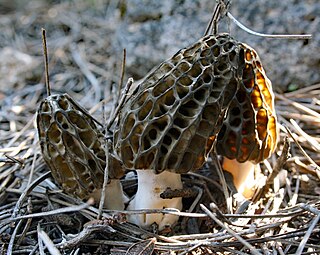
Morchella dunalii is a species of fungus in the family Morchellaceae (Ascomycota). A widespread species in the Mediterranean basin, M. dunalii is so far known from the Balearic islands, the islands of Corsica and Cyprus, France, Spain and Turkey, where it appears to be abundant. It fruits very early in the season on calcareous soil, usually in association with the Aleppo pine, Calabrian pine and holm oak.
Morchella exuberans is a species of fungus in the family Morchellaceae (Ascomycota). It was described as new to science in a 2012 study by Clowez and corresponds to phylogenetic lineage Mel-9. Morchella capitata, described by Kuo and colleagues later in the same year, is a synonym of this taxon.

Morchella sceptriformis is a species of fungus in the family Morchellaceae (Ascomycota). It was described as new to science in a 2012 study by Clowez, and corresponds to phylogenetic lineage Mes-3. Morchella virginiana, described later in the same year by Kuo and colleagues, is conspecific to this taxon.

